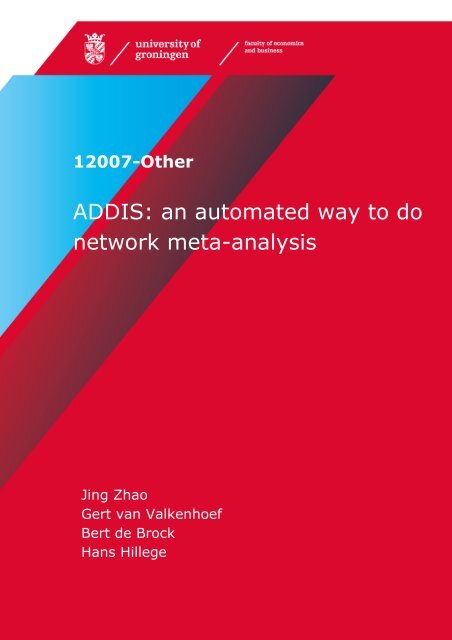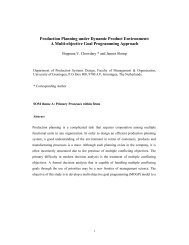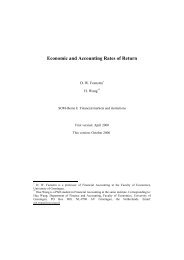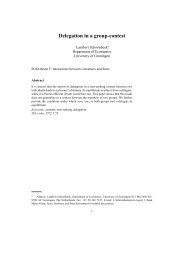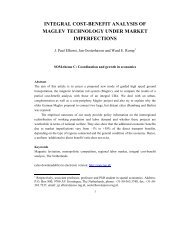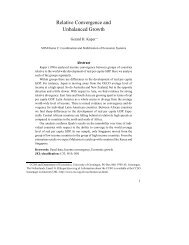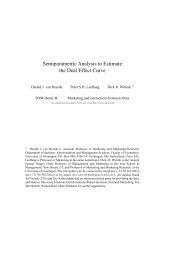ADDIS: an automated way to do network meta-analysis
ADDIS: an automated way to do network meta-analysis
ADDIS: an automated way to do network meta-analysis
Create successful ePaper yourself
Turn your PDF publications into a flip-book with our unique Google optimized e-Paper software.
12007-Other<br />
<strong>ADDIS</strong>: <strong>an</strong> <strong>au<strong>to</strong>mated</strong> <strong>way</strong> <strong>to</strong> <strong>do</strong><br />
<strong>network</strong> <strong>meta</strong>-<strong>an</strong>alysis<br />
Jing Zhao<br />
Gert v<strong>an</strong> Valkenhoef<br />
Bert de Brock<br />
H<strong>an</strong>s Hillege<br />
1
SOM RESEARCH REPORT 12001<br />
SOM is the the research institute of the Faculty of Economics & Business at<br />
the University of Groningen. SOM has six programmes:<br />
- Economics, Econometrics <strong>an</strong>d Fin<strong>an</strong>ce<br />
- Global Economics & M<strong>an</strong>agement<br />
- Hum<strong>an</strong> Resource M<strong>an</strong>agement & Org<strong>an</strong>izational Behaviour<br />
- Innovation & Org<strong>an</strong>ization<br />
- Marketing<br />
- Operations M<strong>an</strong>agement & Operations Research<br />
Research Institute SOM<br />
Faculty of Economics & Business<br />
University of Groningen<br />
Visiting address:<br />
Nettelbosje 2<br />
9747 AE Groningen<br />
The Netherl<strong>an</strong>ds<br />
Postal address:<br />
P.O. Box 800<br />
9700 AV Groningen<br />
The Netherl<strong>an</strong>ds<br />
T +31 50 363 7068/3815<br />
www.rug.nl/som<br />
2
<strong>ADDIS</strong>: <strong>an</strong> <strong>au<strong>to</strong>mated</strong> <strong>way</strong> <strong>to</strong> <strong>do</strong> <strong>network</strong> <strong>meta</strong><strong>an</strong>alysis<br />
Jing Zhao<br />
University of Groningen/UMCG<br />
j.zhao.5@student.rug.nl<br />
Gert v<strong>an</strong> Valkenhoef<br />
University of Groningen<br />
Bert de Brock<br />
University of Groningen<br />
H<strong>an</strong>s Hillege<br />
University of Groningen/UMCG<br />
3
<strong>ADDIS</strong>: <strong>an</strong> <strong>au<strong>to</strong>mated</strong> <strong>way</strong> <strong>to</strong> <strong>do</strong> <strong>network</strong><br />
<strong>meta</strong>-<strong>an</strong>alysis<br />
Jing Zhao *1 , Gert v<strong>an</strong> Valkenhoef 1,2 , Bert de Brock 2 , H<strong>an</strong>s Hillege 1<br />
July 19, 2012<br />
1 Department of Epidemiology, University of Groningen, University Medical Center<br />
Groningen, The Netherl<strong>an</strong>ds<br />
2 Faculty of Economics <strong>an</strong>d Business, University of Groningen, The Netherl<strong>an</strong>ds<br />
Email: Jing Zhao - j.zhao.5@student.rug.nl; Gert v<strong>an</strong> Valkenhoef -<br />
g.h.m.v<strong>an</strong>.valkenhoef@rug.nl; Bert de Brock - e.o.de.brock@rug.nl; H<strong>an</strong>s Hillege -<br />
h.hillege@umcg.nl<br />
* Corresponding author<br />
1 Introduction<br />
In evidence-based medicine, <strong>meta</strong>-<strong>an</strong>alysis is <strong>an</strong> import<strong>an</strong>t statistical technique<br />
for combining the findings from independent clinical trials which have attempted<br />
<strong>to</strong> <strong>an</strong>swer similar questions about treatment’s clinical effectiveness [1]. Normally,<br />
such <strong>meta</strong>-<strong>an</strong>alyses are pair-wise treatment comparisons, which only include<br />
the comparisons between two treatments, e.g. treatment A <strong>an</strong>d placebo.<br />
When additional treatments are of interest (e.g. treatment B <strong>an</strong>d treatment C),<br />
pair-wise treatment comparison starts showing its limitations as it only accesses<br />
the evidence from direct comparisons between two treatments <strong>an</strong>d c<strong>an</strong> not guar<strong>an</strong>tee<br />
consistency between comparisons. Network <strong>meta</strong>-<strong>an</strong>alysis is a statistical<br />
method for combining both direct <strong>an</strong>d indirect evidence from multiple trials in<br />
order <strong>to</strong> obtain a single consistent qu<strong>an</strong>titative synthesis [2, 3, 4]. It enables <strong>to</strong><br />
detect the heterogeneity among different trials comparing the same treatments<br />
<strong>an</strong>d inconsistency between direct <strong>an</strong>d indirect evidence.<br />
Compared <strong>to</strong> pair-wise <strong>meta</strong>-<strong>an</strong>alysis, <strong>network</strong> <strong>meta</strong>-<strong>an</strong>alysis is rather difficult<br />
<strong>to</strong> conduct due <strong>to</strong> the need for <strong>an</strong>alyzing inconsistency, specifying the<br />
model, assessing convergence, etc. The purpose of this report is <strong>to</strong> introduce <strong>an</strong><br />
<strong>au<strong>to</strong>mated</strong> <strong>way</strong> <strong>to</strong> perform <strong>network</strong> <strong>meta</strong>-<strong>an</strong>alysis through <strong>ADDIS</strong> (Aggregate<br />
Data Drug Information System).<br />
1
<strong>ADDIS</strong> is a decision support system developed <strong>to</strong> assist researchers <strong>to</strong> s<strong>to</strong>re<br />
data from clinical trials in a structured <strong>way</strong> <strong>an</strong>d create <strong>meta</strong>-<strong>an</strong>alyses, <strong>network</strong><br />
<strong>meta</strong>-<strong>an</strong>alyses, <strong>an</strong>d benefit-risk assessments in <strong>an</strong> easy <strong>an</strong>d user-friend <strong>way</strong> [5].<br />
It is open source software <strong>an</strong>d c<strong>an</strong> be <strong>do</strong>wnload at http://drugis.org/addis for<br />
free. Algorithms have been developed for <strong>ADDIS</strong> <strong>to</strong> au<strong>to</strong>matically generate<br />
consistency models [6], inconsistency models [7], <strong>an</strong>d node-splitting models [8].<br />
Graphical <strong>an</strong>d qu<strong>an</strong>titative summaries are provided <strong>to</strong> assist the interpretation<br />
<strong>an</strong>d improve the presentation of results from <strong>network</strong> <strong>meta</strong>-<strong>an</strong>alysis. To illustrate<br />
how a <strong>network</strong> <strong>meta</strong>-<strong>an</strong>alysis c<strong>an</strong> be performed in <strong>ADDIS</strong>, we re-<strong>an</strong>alyze<br />
the data from a published systematic review <strong>an</strong>d <strong>network</strong> <strong>meta</strong>-<strong>an</strong>alysis in <strong>an</strong>tihypertensive<br />
therapies [9].<br />
2 Background<br />
Network <strong>meta</strong>-<strong>an</strong>alysis statistically combines the results of a collection of clinical<br />
trials comparing all or some of the treatments of interest. The key assumption<br />
underlying <strong>an</strong>y <strong>meta</strong>-<strong>an</strong>alysis is exch<strong>an</strong>geability of the trials: the trials all measure<br />
the same underlying relative treatment effects; <strong>an</strong>y observed differences are<br />
due <strong>to</strong> ch<strong>an</strong>ce. To apply this definition <strong>to</strong> <strong>network</strong>s in which trials <strong>do</strong> not all<br />
compare the same treatments, we assume that the missing arms are missing “at<br />
r<strong>an</strong><strong>do</strong>m”. Suppose there are three treatments, A, B, <strong>an</strong>d C, <strong>an</strong>d pair-wise comparisons<br />
AB <strong>an</strong>d AC. Then, the assumption is that if <strong>an</strong> AB trial would have<br />
also included a C arm, it would measure the same underlying relative effect for<br />
AC as the AC trials included in the <strong>network</strong>.<br />
The best <strong>way</strong> <strong>to</strong> assess exch<strong>an</strong>geability is <strong>to</strong> collect information about the<br />
clinical trials, <strong>an</strong>d carefully consider whether they are indeed similar enough<br />
<strong>to</strong> be compared. For example, are all the trials of similar duration, or are the<br />
trials that compare A <strong>an</strong>d B much shorter th<strong>an</strong> those that compare B <strong>an</strong>d C?<br />
If we find such a difference, this could have <strong>an</strong> import<strong>an</strong>t impact on whether<br />
the results of a <strong>network</strong> <strong>meta</strong>-<strong>an</strong>alysis are reliable. Other potential confounding<br />
fac<strong>to</strong>rs include <strong>do</strong>sage, study quality, patient inclusion <strong>an</strong>d exclusion criteria,<br />
publication bias, etc. Thus, when defining the dataset for a <strong>network</strong> <strong>meta</strong><strong>an</strong>alysis,<br />
we should be careful <strong>to</strong> ensure that the included clinical trials are as<br />
homogeneous as possible.<br />
If the exch<strong>an</strong>geability assumption is violated in a pair-wise <strong>meta</strong>-<strong>an</strong>alysis,<br />
this may lead <strong>to</strong> heterogeneity: a larger th<strong>an</strong> expected variation in results between<br />
trials. When the amount of heterogeneity is large, it may be inappropriate<br />
<strong>to</strong> calculate <strong>an</strong> overall summary of effect size. On the other h<strong>an</strong>d, there are often<br />
small differences in the population or conduct of trials that lead <strong>to</strong> a minor<br />
amount of heterogeneity. In this case, a relaxed version of the exch<strong>an</strong>geability<br />
assumption may be more appropriate: we allow for some variation between trials,<br />
<strong>an</strong>d attempt <strong>to</strong> model it. Thus, rather th<strong>an</strong> each trial measuring the same<br />
underlying effect (a fixed effects model), the underlying effect of each trial is<br />
drawn from a normal distribution with a common me<strong>an</strong> <strong>an</strong>d vari<strong>an</strong>ce (a r<strong>an</strong><strong>do</strong>m<br />
effects model). In a r<strong>an</strong><strong>do</strong>m effects model, the r<strong>an</strong><strong>do</strong>m effects vari<strong>an</strong>ce is<br />
2
<strong>an</strong> import<strong>an</strong>t qu<strong>an</strong>tity that measures the heterogeneity between trials.<br />
In a <strong>network</strong> <strong>meta</strong>-<strong>an</strong>alysis, a violation of exch<strong>an</strong>geability c<strong>an</strong> also lead <strong>to</strong><br />
differences between (rather th<strong>an</strong> within) comparisons. This is called inconsistency<br />
(<strong>an</strong>d sometimes incoherence): disagreement between direct <strong>an</strong>d indirect<br />
evidence. Note that inconsistency c<strong>an</strong> only be detected when both direct <strong>an</strong>d<br />
indirect evidence are available for a comparison. Thus, if we compare AC indirectly<br />
through AB <strong>an</strong>d BC there could be a systematic difference between the<br />
AB <strong>an</strong>d the BC trials that leads <strong>to</strong> inconsistency, but that inconsistency c<strong>an</strong><br />
not be detected statistically in the absence of AC trials. There are several statistical<br />
models <strong>to</strong> detect inconsistency (discussed below), but it is import<strong>an</strong>t <strong>to</strong><br />
note that even if such a model <strong>do</strong>es not detect inconsistency, that <strong>do</strong>es not me<strong>an</strong><br />
that the <strong>network</strong> indeed consists of exch<strong>an</strong>geable trials. The most import<strong>an</strong>t<br />
step <strong>to</strong> ensure valid results remains the careful selection of trials for inclusion<br />
in the <strong>an</strong>alysis.<br />
2.1 Consistency <strong>an</strong>alysis<br />
In pair-wise <strong>meta</strong>-<strong>an</strong>alysis, we could derive three unrelated estimates of relative<br />
effects dAB, dAC, <strong>an</strong>d dBC from the given trials. In <strong>network</strong> <strong>meta</strong>-<strong>an</strong>alysis,<br />
by contrast, we estimate all three relative effects simult<strong>an</strong>eously through the<br />
consistency constraint: dBC = dAC − dAB. This me<strong>an</strong>s that the parameter dBC<br />
is estimated from both direct evidence on BC <strong>an</strong>d indirect evidence on AC<br />
<strong>an</strong>d AB. When <strong>do</strong>ing a <strong>network</strong> <strong>meta</strong>-<strong>an</strong>alysis, one is normally only interested<br />
in the results under consistency, since only consistent results provide a solid<br />
basis for decision making. However, we c<strong>an</strong> not blindly apply the consistency<br />
model, because <strong>do</strong>ing that will force the results <strong>to</strong> be consistent, even when the<br />
data are not. If that is the case, we could draw incorrect conclusions from the<br />
consistency model.<br />
2.2 Inconsistency <strong>an</strong>alysis<br />
Inconsistency [3] or node-splitting models [10] c<strong>an</strong> be applied <strong>to</strong> check whether<br />
the trials in the <strong>network</strong> are indeed consistent. Both of them are based on<br />
relaxing the consistency constraint. In a r<strong>an</strong><strong>do</strong>m effects model, small differences<br />
between comparisons could also be modeled as heterogeneity. Thus, if a model<br />
with the consistency constraint has much higher r<strong>an</strong><strong>do</strong>m effects vari<strong>an</strong>ce th<strong>an</strong><br />
the individual pair-wise comparisons, that indicates a potential inconsistency<br />
problem.<br />
The inconsistency model assesses inconsistency by adding inconsistency fac<strong>to</strong>rs<br />
<strong>to</strong> closed loops: dBC = dAC − dAB + φ, where φ is <strong>an</strong> inconsistency fac<strong>to</strong>r,<br />
representing the discrep<strong>an</strong>cy between the direct <strong>an</strong>d indirect evidence. The<br />
number of independent (potential) inconsistencies determines the number of inconsistency<br />
fac<strong>to</strong>rs. Each inconsistency fac<strong>to</strong>r lies on a cycle (e.g. ABC) rather<br />
th<strong>an</strong> on individual pair-wise comparisons. The size of <strong>an</strong> inconsistency fac<strong>to</strong>r<br />
reflects the inconsistency within the cycle [3]. The inconsistency fac<strong>to</strong>rs share<br />
a common vari<strong>an</strong>ce, the inconsistency vari<strong>an</strong>ce. It has been suggested that if<br />
3
the inconsistency vari<strong>an</strong>ce is greater th<strong>an</strong> the r<strong>an</strong><strong>do</strong>m effects vari<strong>an</strong>ce, that indicates<br />
<strong>an</strong> inconsistency problem [3]. The inconsistency model c<strong>an</strong> assess all<br />
potential inconsistencies in a single model, but is difficult <strong>to</strong> interpret <strong>an</strong>d may<br />
lack statistical power.<br />
By contrast, a different node splitting model must be estimated for each<br />
comparison that involves both direct <strong>an</strong>d indirect evidence. This is more timeconsuming,<br />
but the results are easier <strong>to</strong> interpret. The node splitting model<br />
selects a single comparison for which the direct <strong>an</strong>d indirect evidence are compared<br />
[10]. Two posterior distributions are obtained for the me<strong>an</strong> treatment<br />
effect, e.g. dBC: one, dDir BC , based on pair-wise <strong>an</strong>alysis of the trials including B<br />
<strong>an</strong>d C, <strong>an</strong>d <strong>an</strong>other, dInd BC , based on indirect comparison through a consistency<br />
model of the trials including A <strong>an</strong>d B <strong>an</strong>d the trials including A <strong>an</strong>d C. The<br />
difference between the two, dDir BC −dInd BC , is called inconsistency parameter. If the<br />
two trials are exch<strong>an</strong>geable, the corresponding inconsistency parameter should<br />
be zero.<br />
2.3 Convergence diagnostics<br />
Network <strong>meta</strong>-<strong>an</strong>alysis models in <strong>ADDIS</strong> are implemented in the Bayesi<strong>an</strong><br />
framework <strong>an</strong>d estimated using Markov chain Monte Carlo (MCMC) methods.<br />
This approach is recommended by the National Institute for Health <strong>an</strong>d<br />
Clinical Excellence (NICE) Decision Support Unit technical support <strong>do</strong>cuments<br />
on evidence synthesis [11] <strong>an</strong>d commonly used in the literature [3, 4, 10, 12].<br />
MCMC methods [13] are extremely flexible in estimating statistical models, but<br />
their application requires some care. The methods work by initially giving the<br />
model’s parameters some arbitrary values (the starting point) <strong>an</strong>d then updating<br />
the parameters each iteration using some s<strong>to</strong>chastic process. In this m<strong>an</strong>ner,<br />
the parameters (samples) generated each iteration are correlated with the samples<br />
generated the previous iteration; this is called a Markov chain. Eventually,<br />
the Markov chain will provide <strong>an</strong> accurate estimate of the statistical model, in<br />
which case we say it has converged. However, how m<strong>an</strong>y iterations are required<br />
<strong>to</strong> get <strong>an</strong> accurate estimate is not known in adv<strong>an</strong>ce.<br />
To determine whether or not sufficient iterations have been generated, convergence<br />
diagnostics have <strong>to</strong> be applied. The Brooks-Gelm<strong>an</strong>-Rubin diagnostic<br />
[14, 15] implemented in <strong>ADDIS</strong> runs several Markov chains with different starting<br />
points <strong>an</strong>d compares their results. When all the chains are similar, this<br />
indicates that the model has converged. Specifically, convergence is assessed by<br />
comparing within-chain <strong>an</strong>d between-chain vari<strong>an</strong>ce <strong>to</strong> calculate the Potential<br />
Scale Reduction Fac<strong>to</strong>r (PSRF) [15]. If the PSRF is large, it me<strong>an</strong>s that the<br />
between-chains vari<strong>an</strong>ce c<strong>an</strong> be decreased by running additional iterations. If<br />
the PSRF is close <strong>to</strong> 1, it indicates approximate convergence has been reached.<br />
An iterative PRSF plot is useful <strong>to</strong> verify that the between-chain vari<strong>an</strong>ce is decreasing<br />
<strong>an</strong>d the within-chain variation is increasing as the simulations converge<br />
[15].<br />
4
3 Example dataset<br />
Psaty et al [9] performed a <strong>network</strong> <strong>meta</strong>-<strong>an</strong>alysis which combined clinical trial<br />
data from 42 studies that included 192,478 patients r<strong>an</strong><strong>do</strong>mized <strong>to</strong> 7 major treatment<br />
strategies for patients with uncomplicated hypertension. The treatment<br />
strategies evaluated in their <strong>network</strong> <strong>meta</strong>-<strong>an</strong>alysis are:<br />
• Placebo<br />
• Diuretic therapy (chlorothiazide or hydrochlorothiazide 12.5 <strong>to</strong> 25 mg/day)<br />
• β-blockers<br />
• Angiotensin-converting enzyme (ACE) inhibi<strong>to</strong>rs<br />
• Angiotensin recep<strong>to</strong>r blockers (ARB)<br />
• Calcium ch<strong>an</strong>nel blockers (CCB)<br />
• α-blockers<br />
Six clinical outcomes are assessed:<br />
• Coronary heart disease (CHD)<br />
• Congestive heart failure (CHF)<br />
• Stroke<br />
• Cardiovascular disease (CVD) events<br />
• CVD mortality<br />
• Total mortality<br />
The <strong>network</strong> of all the treatments from included studies is shown in Figure 1.<br />
4 Implementation in <strong>ADDIS</strong><br />
In this section, we show how <strong>to</strong> reproduce the <strong>network</strong> <strong>meta</strong>-<strong>an</strong>alysis by Psaty et<br />
al [9] in <strong>ADDIS</strong>. We start with a step-by-step instruction for defining the dataset<br />
for the <strong>network</strong> <strong>meta</strong>-<strong>an</strong>alysis. Then we illustrate the consistency <strong>an</strong>alysis <strong>an</strong>d<br />
inconsistency <strong>an</strong>alysis for the outcome “Coronary Heart Disease”. Next we<br />
explain how the assessment of convergence c<strong>an</strong> be <strong>do</strong>ne in <strong>ADDIS</strong>. Finally,<br />
after concluding that there is no discernible inconsistency, we show the results<br />
on all six outcomes based on the results of consistency <strong>an</strong>alysis as Forest plots<br />
relative <strong>to</strong> Diuretics.<br />
5
Figure 1: Network <strong>meta</strong>-<strong>an</strong>alysis of first-line <strong>an</strong>ti-hypertensive drug treatments.<br />
The width of the lines indicates the number of studies that include that comparison<br />
(the minimum is 1 <strong>an</strong>d the maximum is 8)<br />
4.1 Defining the <strong>an</strong>alysis dataset<br />
<strong>ADDIS</strong> assists implementation of <strong>network</strong> <strong>meta</strong>-<strong>an</strong>alysis based on the entered<br />
data (a tu<strong>to</strong>rial of entering data in <strong>ADDIS</strong> is at http://drugis.org/addis1.8).<br />
The dataset for this example c<strong>an</strong> be obtained by “Load example” in <strong>ADDIS</strong>.<br />
The process of defining a <strong>network</strong> <strong>meta</strong>-<strong>an</strong>alysis dataset is presented as a series<br />
of screen shots in Figure 2. By clicking “New Network <strong>meta</strong>-<strong>an</strong>alysis” on the<br />
main win<strong>do</strong>w of <strong>ADDIS</strong>, the user starts this step wise process.<br />
Step 1: Choose a name <strong>an</strong>d <strong>an</strong> indication (Figure 2 (a)). The user gives a<br />
name <strong>to</strong> the <strong>an</strong>alysis (e.g. “Psaty CHD”) <strong>an</strong>d chooses <strong>an</strong> indication (“38341003<br />
Hypertensive disorder” in this example). Based on the chosen indication, the<br />
system selects <strong>an</strong>d presents all the outcome measures from different studies with<br />
this indication.<br />
Step 2: Choose <strong>an</strong> outcome (Figure 2 (b)). The user selects <strong>an</strong> outcome<br />
(“CHD” in this example) that he or she would like <strong>to</strong> <strong>an</strong>alyze. Based on the<br />
chosen outcome, the system selects the studies <strong>an</strong>d treatments that c<strong>an</strong> be<br />
included in the <strong>an</strong>alysis.<br />
Step 3: Choose alternatives (Figure 2 (c)). Based on the available treatments,<br />
the system constructs the evidence graph, where the user c<strong>an</strong> pick the<br />
ones <strong>to</strong> include in the <strong>an</strong>alysis. A green block me<strong>an</strong>s that the treatment is included<br />
<strong>an</strong>d a gray one that it is excluded. The number on the line represents<br />
the number of studies participating in each comparison. The system will not<br />
continue if the selected treatments <strong>do</strong> not form a connected evidence <strong>network</strong>.<br />
Placebo, Diuretics, ACE inhibi<strong>to</strong>r, CCB, ARB, α-blockers, <strong>an</strong>d β-blockers were<br />
selected in this example.<br />
6
(a) Select indication <strong>an</strong>d name (b) Select outcome<br />
(c) Select drugs (d) Select studies<br />
(e) Select arms (f) Overview<br />
Figure 2: Step-wise instruction of defining the dataset for <strong>network</strong> <strong>meta</strong>-<strong>an</strong>alysis<br />
in <strong>ADDIS</strong><br />
Step 4: Choose studies (Figure 2 (d)). The system lists all the studies<br />
measuring at least two of the selected treatments on the selected outcome, <strong>an</strong>d<br />
the user c<strong>an</strong> exclude the ones not desired based on their characteristics. Since<br />
7
the database contains only the studies included in the systematic review [9], all<br />
the studies were included in this example.<br />
Step 5: Choose treatment arms (Figure 2 (e)). When more th<strong>an</strong> one matching<br />
arm is available, the user must choose the appropriate one in this step based<br />
on the arm’s characteristics. The user c<strong>an</strong> go back <strong>to</strong> step 4 <strong>to</strong> exclude the study<br />
if no appropriate arm is available. In this example, “placebo A” was chosen in<br />
study PROGRESS2001 as it is the placebo compared <strong>to</strong> ACE inhibi<strong>to</strong>r which<br />
is included in the <strong>an</strong>alysis.<br />
Step 6: Overview (Figure 2 (f)). The final evidence <strong>network</strong> is shown in the<br />
overview, <strong>an</strong>d if the <strong>network</strong> is not connected, it is not possible <strong>to</strong> finish this<br />
step. In that case, the user needs <strong>to</strong> go back <strong>to</strong> step 3 <strong>to</strong> exclude some of the<br />
treatments. By clicking “Finish”, the system saves the <strong>an</strong>alysis model.<br />
The saved <strong>an</strong>alysis, “Psaty CHD”, c<strong>an</strong> be found under “<strong>network</strong> <strong>meta</strong><strong>an</strong>alysis”<br />
on the left side of <strong>ADDIS</strong> main screen. By selecting it, the user<br />
will get <strong>an</strong> overview of the <strong>network</strong> <strong>meta</strong>-<strong>an</strong>alysis dataset he or she just created.<br />
4.2 Consistency <strong>an</strong>alysis<br />
To run the consistency model, the user should select the section “Consistency”<br />
<strong>an</strong>d then click the run but<strong>to</strong>n. Convergence of the model should be assessed<br />
before drawing conclusions based on the results (see Section 4.4). We extended<br />
the number of iterations once in order <strong>to</strong> achieve good convergence (by clicking<br />
“No, extend” once). Table 1 gives the odds-ratios <strong>an</strong>d the 95% Credibility<br />
Interval (CrI) for all treatments relative <strong>to</strong> each other under the consistency<br />
model. For example, the odds-ratio between ARB <strong>an</strong>d Placebo is 0.94 with<br />
Placebo as baseline <strong>an</strong>d 1.07 with ARB as baseline, so incidence of CHD is<br />
lower for ARB (not signific<strong>an</strong>t). The medi<strong>an</strong> r<strong>an</strong><strong>do</strong>m effects vari<strong>an</strong>ce is 0.15<br />
with 95% CrI (0.03, 0.34). Table 2 gives the probability of each alternative<br />
<strong>to</strong> obtain each r<strong>an</strong>k [4]. R<strong>an</strong>k 1 is the worst indicating the highest incidence<br />
of CHD, <strong>an</strong>d r<strong>an</strong>k 7 is the best indicating the lowest incidence of CHD. For<br />
example, according <strong>to</strong> this r<strong>an</strong>k probability (Table 2), ACE inhibi<strong>to</strong>r <strong>an</strong>d αblockers<br />
are better alternatives compared <strong>to</strong> the other treatments as they have<br />
much higher score on r<strong>an</strong>k 7 (0.38 <strong>an</strong>d 0.33 respectively), which indicates they<br />
have much lower incidence of CHD. On the contrary, Placebo is the worst with<br />
highest r<strong>an</strong>k 1 probability (0.47) <strong>an</strong>d lowest r<strong>an</strong>k 7 probability (0.0). The r<strong>an</strong>k<br />
probabilities sum <strong>to</strong> one, both within a r<strong>an</strong>k over all treatments <strong>an</strong>d within a<br />
treatment over all r<strong>an</strong>ks. The results are also visualized in Figure 3.<br />
4.3 Inconsistency <strong>an</strong>alysis<br />
In our example, trial selection was already taken care of by the systematic review<br />
[9], <strong>an</strong>d thus we could include all relev<strong>an</strong>t studies without further consideration.<br />
Thus, we go directly <strong>to</strong> statistical modeling <strong>to</strong> detect inconsistency.<br />
8
Table 1: Relative effects table from the consistency model. Odds-ratio (95%<br />
Credibility Interval). ACE indicates <strong>an</strong>giotensin-converting enzyme; CCB indicates<br />
calcium ch<strong>an</strong>nel blockers; <strong>an</strong>d ARB indicates <strong>an</strong>giotensin recep<strong>to</strong>r blockers.<br />
ACE inhibi<strong>to</strong>r<br />
0.80<br />
1.26 1.19 1.18 1.03 1.04 1.34<br />
(0.77, 2.06) (0.90, 1.58) (0.95, 1.47) (0.83, 1.26) (0.67, 1.60) (1.05, 1.72)<br />
ARB<br />
0.95 0.94 0.82 0.82 1.07<br />
(0.48, 1.31) (0.63, 1.58) (0.57, 1.55) (0.50, 1.33) (0.44, 1.53) (0.67, 1.69)<br />
0.84 1.05<br />
β-blockers<br />
0.99 0.86 0.87 1.12<br />
(0.63, 1.11) (0.70, 1.58) (0.74, 1.32) (0.66, 1.12) (0.55, 1.37) (0.90, 1.40)<br />
0.85 1.07 1.01<br />
CCB<br />
0.87 0.88 1.14<br />
(0.68, 1.06) (0.65, 1.77) (0.76, 1.36) (0.70, 1.09) (0.57, 1.36) (0.88, 1.47)<br />
0.97 1.23 1.16 1.15<br />
Diuretics<br />
1.01 1.31<br />
(0.79, 1.20) (0.75, 1.99) (0.90, 1.51) (0.92, 1.43) (0.69, 1.47) (1.06, 1.62)<br />
0.96 1.21 1.15 1.14 0.99<br />
α-blockers<br />
(0.63, 1.48) (0.65, 2.25) (0.73, 1.82) (0.73, 1.76) (0.68, 1.44) (0.84, 1.99)<br />
0.74 0.94 0.89 0.88 0.76 0.77<br />
Placebo<br />
(0.58, 0.95) (0.59, 1.49) (0.72, 1.11) (0.68, 1.14) (0.62, 0.94) (0.50, 1.19)<br />
Table 2: Probability for each alternative <strong>to</strong> be at each r<strong>an</strong>k given the <strong>an</strong>alysis<br />
model <strong>an</strong>d the data. R<strong>an</strong>k 1 me<strong>an</strong>s highest incidence of Coronary Heart Disease<br />
<strong>an</strong>d r<strong>an</strong>k 7 the lowest. ACE indicates <strong>an</strong>giotensin-converting enzyme; CCB<br />
indicates calcium ch<strong>an</strong>nel blockers; <strong>an</strong>d ARB indicates <strong>an</strong>giotensin recep<strong>to</strong>r<br />
blockers.<br />
Drug R<strong>an</strong>k 1 R<strong>an</strong>k 2 R<strong>an</strong>k 3 R<strong>an</strong>k 4 R<strong>an</strong>k 5 R<strong>an</strong>k 6 R<strong>an</strong>k 7<br />
ACE inhibi<strong>to</strong>r 0.00 0.01 0.03 0.07 0.21 0.30 0.38<br />
ARB 0.35 0.19 0.15 0.10 0.06 0.06 0.09<br />
-Blockers 0.05 0.23 0.37 0.19 0.10 0.05 0.02<br />
CCB 0.07 0.17 0.21 0.35 0.15 0.05 0.01<br />
Diuretics 0.00 0.01 0.03 0.10 0.30 0.39 0.17<br />
-Blockers 0.06 0.07 0.08 0.14 0.17 0.15 0.33<br />
Placebo 0.47 0.33 0.14 0.04 0.01 0.00 0.00<br />
4.3.1 Node split model<br />
To run the node split model, the user should select the section “Node Split”<br />
<strong>an</strong>d then click “Run all node-split models” or click the run but<strong>to</strong>n for each<br />
node split model separately. Convergence of each model should be assessed<br />
before drawing conclusions based on the results (see Section 4.4). Table 3 lists<br />
the relative effect from direct <strong>an</strong>d indirect evidence <strong>an</strong>d the signific<strong>an</strong>ce level<br />
of the evidence. The p-values show no signific<strong>an</strong>t difference between the direct<br />
effect <strong>an</strong>d indirect effect. We present the density plots of the best comparison<br />
(β-blockers vs. Placebo with p=0.95) <strong>an</strong>d the worst comparison (ACE inhibi<strong>to</strong>r<br />
vs. β-blockers with p=0.09) in Figure 4a <strong>an</strong>d 4b, respectively. We c<strong>an</strong> see that<br />
in the best comparison, the relative effect plots from direct evidence, indirect<br />
evidence, <strong>an</strong>d consistency model resemble each other, while the ones in the worst<br />
9<br />
1.30
Figure 3: Visualized r<strong>an</strong>k probabilities. ACE indicates <strong>an</strong>giotensin-converting<br />
enzyme <strong>an</strong>d ARB indicates <strong>an</strong>giotensin recep<strong>to</strong>r blockers.<br />
comparison are more divergent. In general, the results from the node split model<br />
show no signific<strong>an</strong>t inconsistency is present in this dataset.<br />
Table 3: Node splitting model. Log odds-ratio (95% credibility interval). ACE<br />
indicates <strong>an</strong>giotensin-converting enzyme; CCB indicates calcium ch<strong>an</strong>nel blockers;<br />
<strong>an</strong>d ARB indicates <strong>an</strong>giotensin recep<strong>to</strong>r blockers.<br />
Name Direct effect Indirect effect Overall P<br />
d.ACE inhibi<strong>to</strong>r.Diurectics 0.06(-0.17,0.31) -0.16(-0.43,0.17) 0.02(-0.19,0.24) 0.23<br />
d.ACE inhibi<strong>to</strong>r.Placebo 0.09(-0.46,0.62) 0.36(0.08,0.64) 0.29(0.04,0.54) 0.38<br />
d.-blockers.ACE inhibi<strong>to</strong>r 0.20(-0.32,0.74) -0.31(-0.64,-0.01) -0.18(-0.45,0.10) 0.09<br />
d.-blockers.Diuretics -0.47(-0.97,-0.01) -0.05(-0.34,0.22) -0.16(-0.41,0.11) 0.11<br />
d.-blockers.Placebo 0.10(-0.17,0.35) 0.09(-0.33,0.51) 0.11(-0.11,0.33) 0.95<br />
d.CCB.ACE inhibi<strong>to</strong>r -0.22(-0.56,0.02) 0.02(-0.37,0.43) -0.15(-0.40,0.04) 0.27<br />
d.CCB.-blockers -0.03(-0.80,0.74) 0.03(-0.33,0.32) 0.03(-0.30,0.29) 0.89<br />
d.CCB.Diuretics -0.06(-0.36,0.21) -0.20(-0.61,0.13) -0.13(-0.38,0.07) 0.48<br />
d.CCB.Placebo 0.31(-0.26,0.90) 0.09(-0.26,0.36) 0.14(-0.15,0.37) 0.47<br />
d.Diuretics.Placebo 0.30(0.04,0.56) 0.25(-0.08,0.59) 0.27(0.05,0.47) 0.80<br />
10
(a) -blockers vs. Placebo<br />
(b) ACE inhibi<strong>to</strong>r vs. -blockers<br />
Figure 4: Density plot of direct <strong>an</strong>d indirect evidence . The red line represents<br />
the evidence from direct comparisons, the blue line represents the evidence<br />
from indirect comparisons, <strong>an</strong>d the green line represents the evidence from the<br />
consistency <strong>an</strong>alysis. ACE indicates <strong>an</strong>giotensin-converting enzyme.<br />
11
4.3.2 Inconsistency model<br />
To run the inconsistency model, the user should select the section “Inconsistency”<br />
<strong>an</strong>d then click the run but<strong>to</strong>n. Convergence of the model should be<br />
assessed before drawing conclusions based on the results (see Section 4.4). We<br />
extended the number of iterations twice in order <strong>to</strong> achieve good convergence<br />
(by clicking “No, extend” twice). The inconsistency fac<strong>to</strong>rs (Table 4) were calculated<br />
as medi<strong>an</strong> <strong>an</strong>d 95% credibility interval. From the results we c<strong>an</strong> see<br />
that all the intervals include 0 which suggests no signific<strong>an</strong>t inconsistency. Even<br />
in the most extreme inconsistency fac<strong>to</strong>r, 0.08 (-0.16, 0.63), the medi<strong>an</strong> value<br />
is within one st<strong>an</strong>dard deviation from zero. The inconsistency vari<strong>an</strong>ce is not<br />
much different from the r<strong>an</strong><strong>do</strong>m effects vari<strong>an</strong>ce (Table 5). Therefore, the results<br />
show no relev<strong>an</strong>t inconsistency, which indicates that the studies included<br />
in these comparisons did not lead <strong>to</strong> inconsistencies.<br />
In addition, the inconsistency model also provides a relative effects table<br />
which c<strong>an</strong> be compared <strong>to</strong> the one from the consistency model (Table 1). In<br />
this example, the relative effects from inconsistency model are comparable <strong>to</strong><br />
the ones from consistency table, indicating no relev<strong>an</strong>t inconsistency. Note that<br />
the consistency assumption is critical for decision making <strong>an</strong>d so the results of<br />
<strong>an</strong> inconsistency model should never be used <strong>to</strong> draw conclusions about the<br />
relative effects of the included treatments.<br />
Table 4: Inconsistency fac<strong>to</strong>rs. CrI indicates credibility interval; ACE indicates<br />
<strong>an</strong>giotensin-converting enzyme; CCB indicates calcium ch<strong>an</strong>nel blockers; <strong>an</strong>d<br />
ARB indicates <strong>an</strong>giotensin recep<strong>to</strong>r blockers.<br />
Cycle Medi<strong>an</strong> (95% CrI)<br />
ACE inhibi<strong>to</strong>r, β-blockers, CCB -0.07(-0.54,0.17)<br />
ACE inhibi<strong>to</strong>r, CCB, β-blockers, Diuretics -0.06(-0.56,0.21)<br />
ACE inhibi<strong>to</strong>r, CCB, β-blockers, Placebo, Diuretics 0.02(-0.37,0.42)<br />
β-blockers, CCB, Diuretics 0.08(-0.16,0.63)<br />
β-blockers, CCB, Diuretics, Placebo 0.01(-0.29,0.38)<br />
CCB, Diuretics, Placebo -0.03(-0.47,0.27)<br />
Table 5: Vari<strong>an</strong>ce calculation. CrI indicates credibility interval.<br />
Parameter Medi<strong>an</strong> (95% CrI)<br />
R<strong>an</strong><strong>do</strong>m Effects Vari<strong>an</strong>ce 0.15(0.04,0.34)<br />
Inconsistency Vari<strong>an</strong>ce 0.17(0.01,0.66)<br />
4.4 Convergence diagnostics<br />
When <strong>ADDIS</strong> asks <strong>to</strong> assess convergence (Figure 5), the user should click the<br />
but<strong>to</strong>n “show convergence”. Then, <strong>ADDIS</strong> will show the convergence assessment<br />
dialog (Figure 6). If convergence is reached, the user could click “Yes,<br />
12
finish” <strong>to</strong> finish the MCMC simulation. Otherwise, the user could click “No,<br />
extend” <strong>to</strong> let the model run for more iterations until convergence is adequate.<br />
The PRSF in the convergence parameter table is just a snapshot result at the<br />
end of the simulation. To check whether the convergence is reached stably or<br />
only temporarily, we need <strong>to</strong> look at the convergence plots. By <strong>do</strong>uble clicking a<br />
parameter in the convergence table, the user c<strong>an</strong> obtain the convergence plots.<br />
For example, Figure 6 shows the convergence table of the consistency model <strong>an</strong>d<br />
Figure 7 shows the convergence plot of the parameter of β-blockers vs. ACE<br />
inhibi<strong>to</strong>rs. From the plot we c<strong>an</strong> see that the PSRF is quite far a<strong>way</strong> from one<br />
in the beginning before approximate convergence has been reached <strong>an</strong>d close<br />
<strong>to</strong> one after 5,000 iterations, <strong>an</strong>d the convergence is very stable after 50,000<br />
iterations.<br />
Figure 5: The progress indication after the simulation phase has been completed.<br />
The user is prompted <strong>to</strong> assess convergence.<br />
Figure 6: Convergence parameter table from the consistency model.<br />
4.5 Overall results<br />
As there is no relev<strong>an</strong>t inconsistency in the evidence (as determined by Psaty<br />
et al [9] for the remaining outcomes), we c<strong>an</strong> use the consistency model <strong>to</strong> draw<br />
conclusion about the relative effects of the included treatments. The relative<br />
13
Figure 7: Convergence plot of chain β-blockers <strong>an</strong>d Angiotensin-Converting Enzyme<br />
inhibi<strong>to</strong>rs. PSRF indicates potential scale reduction fac<strong>to</strong>r. The iteration<br />
number is thinned by fac<strong>to</strong>r 10, so for example iteration 5,000 in the figure<br />
actually corresponds with iteration 50,000.<br />
effects (odds-ratio) between Diuretics <strong>an</strong>d other <strong>an</strong>ti-hypertensive therapies are<br />
plotted in Figure 8 based on a consistency <strong>an</strong>alysis in <strong>ADDIS</strong><br />
5 Discussion<br />
In this report, we introduced <strong>ADDIS</strong> as <strong>an</strong> <strong>au<strong>to</strong>mated</strong> <strong>way</strong> <strong>to</strong> perform <strong>network</strong><br />
<strong>meta</strong>-<strong>an</strong>alysis. <strong>ADDIS</strong> is <strong>an</strong> integrated software application providing decision<br />
support based on clinical trial results. Besides creating <strong>network</strong> <strong>meta</strong>-<strong>an</strong>alysis,<br />
<strong>ADDIS</strong> also enables the construction of pair-wise <strong>meta</strong>-<strong>an</strong>alysis <strong>an</strong>d benefit-risk<br />
decision models.<br />
For <strong>network</strong> <strong>meta</strong>-<strong>an</strong>alysis, <strong>ADDIS</strong> supports both continuous <strong>an</strong>d dicho<strong>to</strong>mous<br />
outcomes, <strong>an</strong>d provides two <strong>way</strong>s <strong>to</strong> assess inconsistency. The user interface<br />
facilitates convergence checking <strong>an</strong>d interpretation of the results, with<br />
figures <strong>an</strong>d tables tailored <strong>to</strong> each model.<br />
5.1 Analysis of the example dataset<br />
To illustrate the application of <strong>ADDIS</strong> for <strong>network</strong> <strong>meta</strong>-<strong>an</strong>alysis, the aggregated<br />
data from a systematic review were used. The inconsistency <strong>an</strong>alysis shows<br />
no signific<strong>an</strong>t inconsistency between the direct evidence <strong>an</strong>d indirect evidence,<br />
therefore we assume that the consistency model is valid. Otherwise, there would<br />
be a need <strong>to</strong> investigate the source for inconsistency from the involved studies<br />
<strong>an</strong>d exclude them <strong>an</strong>d run the model until there is no signific<strong>an</strong>t inconsistency.<br />
Psaty et al calculated the logarithm of the risk-ratio (RR), while <strong>ADDIS</strong><br />
calculates the logarithm of the odds-ratio (OR). The OR <strong>an</strong>d RR are similar<br />
when the event is rare, but differ subst<strong>an</strong>tially when the event is common.<br />
However, in <strong>network</strong> <strong>meta</strong>-<strong>an</strong>alysis, the log OR is more suitable th<strong>an</strong> the log<br />
RR because the former has better mathematical properties <strong>an</strong>d often reflects the<br />
14
underlying mech<strong>an</strong>isms more effectively. It <strong>do</strong>es not matter whether we <strong>an</strong>alyze<br />
the event or non-event with OR, but with RR it requires care in choosing event<br />
or non-event. This is because the OR of <strong>an</strong> event is reciprocal with the OR of<br />
the corresponding non-event, which makes the calculation much easier.<br />
The relative effects based on consistency model are consistent between the<br />
results from <strong>ADDIS</strong> <strong>an</strong>d the ones from the systematic review. There are some<br />
small differences due <strong>to</strong> different <strong>way</strong>s <strong>to</strong> deal with some treatment arms. The<br />
differences mainly focus on Diuretics vs. β-Blockers (Figure 8b) <strong>an</strong>d Diuretics<br />
vs. ARB (Figure 8e) on outcome CHF. Although neither of them reaches a signific<strong>an</strong>t<br />
level, the results show the opposite favorable alternative. The difference<br />
on Diuretics vs β-Blockers is due <strong>to</strong> the <strong>way</strong> the treatment arm “β-blocker or diuretics”<br />
was <strong>an</strong>alyzed. There are five studies including “β-blocker or diuretics”<br />
as a single treatment group in the systematic review. This treatment arm was<br />
assessed as two separate treatments by weighing 68% <strong>to</strong> β-blocker <strong>an</strong>d 32% <strong>to</strong><br />
diuretics because this allocation was reported in one study. However, how the<br />
other four studies treat it is unknown. Therefore, this arm was excluded in our<br />
<strong>network</strong> <strong>meta</strong>-<strong>an</strong>alysis. This could also influence the results between Diuretics<br />
<strong>an</strong>d ARB because there is no direct evidence comparing them. ARB was only<br />
compared directly with Placebo, β-Blockers <strong>an</strong>d CCB. Therefore the results in<br />
Figure 8e are estimated through indirect evidence, such as, ARB is compared<br />
with β-Blockers <strong>an</strong>d β-Blockers is compared with Diuretics. Since the comparison<br />
between β-Blockers <strong>an</strong>d Diuretics is influenced by the mixed arm “β-blocker<br />
or diuretics”, the comparison between ARB <strong>an</strong>d Diuretics is also influenced.<br />
5.2 Future work<br />
In the future, <strong>ADDIS</strong> will enable the <strong>an</strong>alysis of more complicated data, such<br />
as survival data (time-<strong>to</strong>-event data), <strong>an</strong>d will enable the generation of Forest<br />
plots for relative effects on pair-wise comparisons. It will be possible <strong>to</strong> stratify<br />
treatments by <strong>do</strong>se. For example, currently in <strong>ADDIS</strong>, treatment A is defined<br />
as drug X, but in the future, treatment A c<strong>an</strong> be defined as low-<strong>do</strong>se drug X<br />
<strong>an</strong>d treatment B c<strong>an</strong> be defined as high-<strong>do</strong>se drug X.<br />
Future work will also include additional methods <strong>to</strong> assess convergence <strong>an</strong>d<br />
run length, new <strong>to</strong>ols <strong>to</strong> make it easier <strong>to</strong> identify the studies that are causing<br />
inconsistency (e.g. independent me<strong>an</strong> effects model), <strong>to</strong>ols for study selection<br />
<strong>an</strong>d treatment definition, <strong>an</strong>d <strong>meta</strong>-regression <strong>to</strong> model the effect of covariates<br />
(e.g. <strong>to</strong> correct for trial duration or <strong>do</strong>sage).<br />
References<br />
[1] M. Egger, G. D. Smith, <strong>an</strong>d A. N. Phillips. Meta-<strong>an</strong>alysis: principles <strong>an</strong>d<br />
procedures. BMJ, 315:1533, 1997.<br />
[2] T. Lumley. Network <strong>meta</strong>-<strong>an</strong>alysis for indirect treatment comparisons.<br />
Statistics in Medicine, 21(16):2313–2324, 2002.<br />
15
[3] G. Lu <strong>an</strong>d A. E. Ades. Assessing evidence inconsistency in mixed treatment<br />
comparisons. Journal of Americ<strong>an</strong> Statistical Association, 101(474):447–<br />
459, 2006.<br />
[4] G. Sal<strong>an</strong>ti, J. P. T. Higgins, A. E. Ades, <strong>an</strong>d J. P. A. Io<strong>an</strong>nidis. Evaluation<br />
of <strong>network</strong>s of r<strong>an</strong><strong>do</strong>mized trials. Statistical Methods in Medical Research,<br />
17(3):279–301, 2008.<br />
[5] G. v<strong>an</strong> Valkenhoef, T. Tervonen, T. Zwinkels, B. de Brock, <strong>an</strong>d H. Hillege.<br />
Addis: a decision support system for evidence-based medicine. Decision<br />
Support Systems, In press, 2012.<br />
[6] G. v<strong>an</strong> Valkenhoef, G. Lu, B. de Brock, H. Hillege, A. E. Ades, <strong>an</strong>d N. J.<br />
Wel<strong>to</strong>n. Au<strong>to</strong>mating <strong>network</strong> <strong>meta</strong>-<strong>an</strong>alysis. Submitted m<strong>an</strong>uscript, 2012.<br />
[7] G. v<strong>an</strong> Valkenhoef, T. Tervonen, B. de Brock, <strong>an</strong>d H. Hillege. Algorithmic<br />
parameterization of mixed treatment comparisons. Statistics <strong>an</strong>d Computing,<br />
in press, 2011.<br />
[8] G. v<strong>an</strong> Valkenhoef, S. Dias, N. S. Weiss, <strong>an</strong>d A. E. Ades. Au<strong>to</strong>mated<br />
generation of mixed treatment comparison node-splitting models. draft<br />
m<strong>an</strong>uscript, 2012.<br />
[9] B. M. Psaty, T. Lumley, C. D. Furberg, G. Schellenbaum, M. Pahor, M. H.<br />
Alderm<strong>an</strong>, <strong>an</strong>d N. S. Weiss. Health outcomes associated with various <strong>an</strong>tihypertensive<br />
therapies used as first-line agents: a <strong>network</strong> <strong>meta</strong>-<strong>an</strong>alysis.<br />
JAMA, 289(19):2534–2544, 2003.<br />
[10] S. Dias, N. J. Wel<strong>to</strong>n, D. M. Caldwell, <strong>an</strong>d A. E. Ades. Checking consistency<br />
in mixed treatment comparison <strong>meta</strong>-<strong>an</strong>alysis. Statistics in Medicine,<br />
29:932–944, 2010.<br />
[11] S. Dias, N. J. Wel<strong>to</strong>n, A. J. Sut<strong>to</strong>n, <strong>an</strong>d A. E. Ades. Technical support<br />
<strong>do</strong>cuments 2: a generalised linear modelling framework for pairwise <strong>an</strong>d<br />
<strong>network</strong> <strong>meta</strong>-<strong>an</strong>alysis of r<strong>an</strong><strong>do</strong>mized controlled trials. Technical report,<br />
2011.<br />
[12] G. Lu <strong>an</strong>d A. E. Ades. Combination of direct <strong>an</strong>d indirect evidence in mixed<br />
treatment comparison. Statistics in Medicine, 23(20):3105–3124, 2004.<br />
[13] C. P. Robert <strong>an</strong>d G. Casella. Monte Carlo statistical methods. Springer,<br />
2nd edition, 2004.<br />
[14] A. Gelm<strong>an</strong> <strong>an</strong>d D. B. Rubin. Inference from iterative simulation using<br />
multiple sequences. StatSci, 7(4):457–572, 1992.<br />
[15] S.P. Brooks <strong>an</strong>d A. Gelm<strong>an</strong>. General methods for moni<strong>to</strong>ring convergence<br />
of iterative simulations. Computational <strong>an</strong>d Graphical Statistics, 7(4):434–<br />
455, 1998.<br />
16
Criterion<br />
Criterion<br />
Criterion<br />
CHD<br />
CHF<br />
Stroke<br />
CVD event<br />
CVD mortality<br />
Total mortality<br />
0.63 0.79 1.00 1.26 1.58<br />
Odds−ratio compared <strong>to</strong> Diuretics<br />
(a) Diuretics vs Placebo<br />
CHD<br />
CHF<br />
Stroke<br />
CVD event<br />
CVD mortality<br />
Total mortality<br />
0.63 0.79 1.00 1.26 1.58<br />
Odds−ratio compared <strong>to</strong> Diuretics<br />
(c) Diuretics vs ACE inhibi<strong>to</strong>r<br />
CHD<br />
CHF<br />
Stroke<br />
CVD event<br />
CVD mortality<br />
Total mortality<br />
0.63 0.79 1.00 1.26 1.58<br />
Odds−ratio compared <strong>to</strong> Diuretics<br />
(e) Diuretics vs ARB<br />
Criterion<br />
Criterion<br />
Criterion<br />
CHD<br />
CHF<br />
Stroke<br />
CVD event<br />
CVD mortality<br />
Total mortality<br />
0.63 0.79 1.00 1.26 1.58<br />
Odds−ratio compared <strong>to</strong> Diuretics<br />
(b) Diuretics vs -Blockers<br />
CHD<br />
CHF<br />
Stroke<br />
CVD event<br />
CVD mortality<br />
Total mortality<br />
CHD<br />
CHF<br />
0.63 0.79 1.00 1.26 1.58<br />
Odds−ratio compared <strong>to</strong> Diuretics<br />
(d) Diuretics vs CCB<br />
Stroke<br />
CVD event<br />
CVD mortality<br />
Total mortality<br />
0.63 0.79 1.00 1.26 1.58<br />
Odds−ratio compared <strong>to</strong> Diuretics<br />
(f) Diuretics vs -Blockers<br />
Figure 8: Relative effects between Diuretics <strong>an</strong>d other treatments. Odds-ratio<br />
below one favors Diuretics. CHD indicates coronary heart disease; CHF indicates<br />
congestive heart failure; CVD indicates cardiovascular disease; ACE indicates<br />
<strong>an</strong>giotensin-converting enzyme; CCB indicates calcium ch<strong>an</strong>nel blockers;<br />
<strong>an</strong>d ARB indicates <strong>an</strong>giotensin recep<strong>to</strong>r blockers.<br />
17
List of research reports<br />
12001-HRM&OB: Veltrop, D.B., C.L.M. Hermes, T.J.B.M. Postma <strong>an</strong>d J. de Ha<strong>an</strong>, A Tale<br />
of Two Factions: Exploring the Relationship between Factional Faultlines <strong>an</strong>d Conflict<br />
M<strong>an</strong>agement in Pension Fund Boards<br />
12002-EEF: Angelini, V. <strong>an</strong>d J.O. Mierau, Social <strong>an</strong>d Economic Aspects of Childhood<br />
Health: Evidence from Western-Europe<br />
12003-Other: Valkenhoef, G.H.M. v<strong>an</strong>, T. Tervonen, E.O. de Brock <strong>an</strong>d H. Hillege, Clinical<br />
trials information in drug development <strong>an</strong>d regulation: existing systems <strong>an</strong>d st<strong>an</strong>dards<br />
12004-EEF: Toolsema, L.A. <strong>an</strong>d M.A. Allers, Welfare fin<strong>an</strong>cing: Gr<strong>an</strong>t allocation <strong>an</strong>d<br />
efficiency<br />
12005-EEF: Boonm<strong>an</strong>, T.M., J.P.A.M. Jacobs <strong>an</strong>d G.H. Kuper, The Global Fin<strong>an</strong>cial Crisis<br />
<strong>an</strong>d currency crises in Latin America<br />
12006-EEF: Kuper, G.H. <strong>an</strong>d E. Sterken, Participation <strong>an</strong>d Perform<strong>an</strong>ce at the Lon<strong>do</strong>n<br />
2012 Olympics<br />
12007-Other: Zhao, J., G.H.M. v<strong>an</strong> Valkenhoef, E.O. de Brock <strong>an</strong>d H. Hillege, <strong>ADDIS</strong>: <strong>an</strong><br />
<strong>au<strong>to</strong>mated</strong> <strong>way</strong> <strong>to</strong> <strong>do</strong> <strong>network</strong> <strong>meta</strong>-<strong>an</strong>alysis<br />
1


